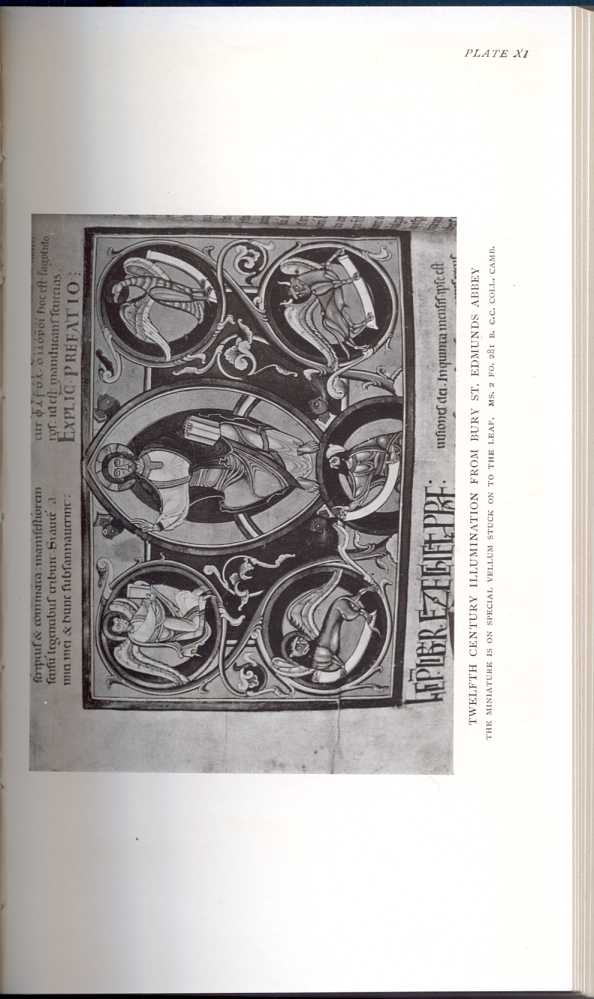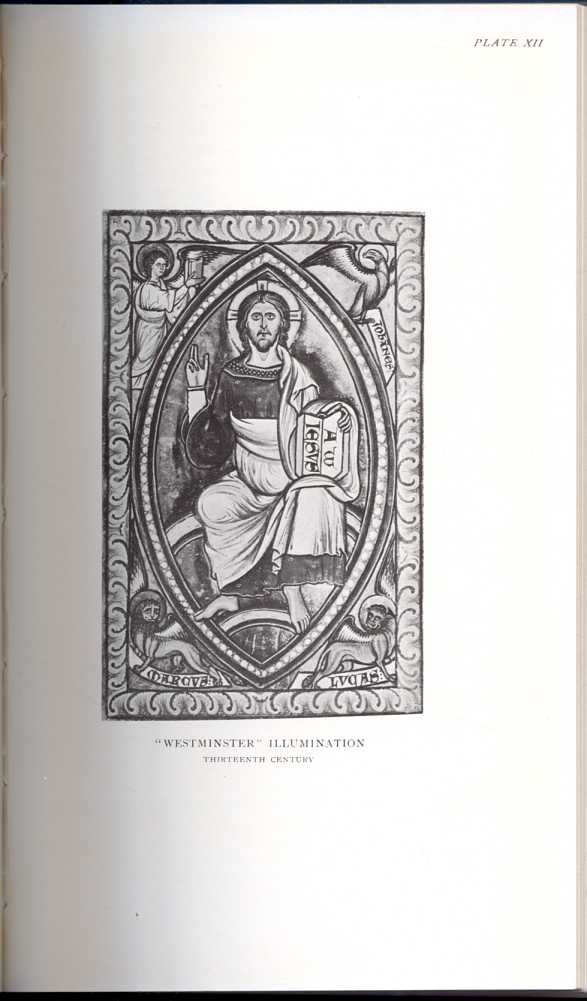| CHAPTER III: LIBRARIES OF THE GREAT ABBEYS—BOOK-LOVERS AMONG THE
MENDICANTS—DISPERSAL OF MONKISH LIBRARIES Old English libraries; the making, collection and use of books during the middle ages | ||
4. § IV
The whole truth about the later days of the monasteries will
never be known. Many of the original sources of our knowledge are
tainted with partisanship and religious rancour and flagrant dishonesty.
What does seem to be true is that in the fourteenth and fifteenth
centuries monastic influence grew slowly weaker, although the system may
not have been degenerate in itself. The cause is to be found in the very
prosperity of monachism, which brought to the religious houses wealth
and all its responsibilities. Wealth always imposes fetters, as every
rich man, from Seneca downwards, has declared with unctuous lamentation.
But
 [Description: TWELFTH CENTURY ILLUMINATION FROM BURY
ST. EDMUNDS ABBEY THE MINIATURE IS ON SPECIAL VELLUM STUCK ON TO THE
LEAF. MS. 2 FO. 281 S. C.C. COLL. CAMB.]
[Description: TWELFTH CENTURY ILLUMINATION FROM BURY
ST. EDMUNDS ABBEY THE MINIATURE IS ON SPECIAL VELLUM STUCK ON TO THE
LEAF. MS. 2 FO. 281 S. C.C. COLL. CAMB.]
In the hastiness of the overthrow some conventual books were destroyed, or stolen, or sold off at low prices. In a few places damage was done even before the actual dissolution. At Christ Church, Canterbury, for example, the drunken servants of a royal commission carelessly brought about a fire, almost entirely destroying the
- Item, sold to Robert Doryngton, old boke, and a cofer in the library . . . . . ijs.
- Item, old bokes in the vestry, sold to the same Robert . . . . . viiid.
- Item, sold to Robert Whytgreve, a missale . . . . . viijd.
- Fyrst, sold to Mr. Whytgreve, a masse boke. . . . . xijd.
- Item, old bokes in the quyer. . . . . vjd.
- Item, a fryers masse boke, solde to Marke Wyrley . . . . . iiijd.[3.69]
Bale's statement is sadly borne out by the fate of the library of the Austin Friars of York. At one time this friary owned between six and seven hundred books. Now but five are known to remain. [3.70] "It is hardly open to doubt," writes Dr. James, "that nine-tenths of the books have ceased to exist. To be sure, it is no news to us that thousands, perhaps hundreds of thousands, of manuscripts were destroyed in the first half of the sixteenth century; but the truth comes heavily home when we are confronted with the actual figures of the loss sustained in one small corner of the field. We may fairly reckon that what
But the loss may be—and has been—exaggerated. In some instances a good part of a library was preserved. The Prior of Lanthony, a house in the outskirts of Gloucester, saved the books of his little community. From him they passed into the hands of one Theyer; later, possibly through Archbishop Bancroft, they found an ultimate resting-place in Lambeth Palace. During this interval many of them were perhaps lost or sold, but to-day some one hundred and thirty are known certainly to have come from Lanthony, or may be credited to that place on reasonably safe evidence.[3.72]
Then again Henry's myrmidons—to use the classic word—would be
unlikely to carry their vandalism too far. To do so, in view of the
great value of books, would bring them no profit. Knowing their
character, may we not reasonably assume that they sold as many books as
they could to make illicit gains?[3.73]
Sometimes they fell in love with their finds, as was natural. "Please it
you to understand," writes Thomas Bedyll, one of Henry VIII's
commissioners, "that in the reding of the muniments and chartors of the
house of Ramesey, I found a chartor of King Edgar, writen in a very
antiq Romane hand, hard to be red at the first sight, and light inowghe
after that a man found out vj or vij words and after compar letter to
letter. I am suer ye wold delight to see the same for the straingnes and
antiquite thereof.... I have seen also there a chartor of King Edward
writen affor the Conquest."[3.74]
 [Description: "WESTMINSTER" ILLUMINATION
THIRTEENTH CENTURY]
[Description: "WESTMINSTER" ILLUMINATION
THIRTEENTH CENTURY]
John Leland was one of those who saved books. Already he had been commissioned to examine the libraries of cathedrals, abbeys, priories, colleges, and other places wherein the records of antiquity were kept, when, observing with dismay the threatened loss of monastic treasures, he asked Cromwell to extend the commission to collecting books for the king's library. The Germans, he says, perceiving our "desidiousness" and negligence, were daily sending young scholars hither, who spoiled the books, and cut them out of libraries, and returned home and put them abroad as monuments of their own country.[3.75]
His request was granted in part, and he tells us he sent to London for the royal library the choicest volumes in St. Augustine's Abbey; but very few of these books now remain. [3.76] He had, he said, "conservid many good autors, the which otherwise had beene like to have perischid to no smaul incommodite of good letters, of the whiche parse remayne yn the moste magnificent libraries of yowr royal Palacis. Parte also remayne yn my custodye. Wherby I truste right shortely so to describe your most noble reaulme, and to publische the Majeste and the excellent actes of yowr progenitors."[3.77]
Robert Talbot, rector of Haversham, Berkshire (d. 1558), collected monastic manuscripts: the choicest of them he left to New College. A portreeve of Ipswich, named William Smart, came into possession of some hundred volumes from Bury Abbey library. In 1599 he gave them to Pembroke College, where they are now. [3.78] John Twyne, (d. 1581), schoolmaster and mayor of Canterbury, certainly once owned the fifteenth-century catalogue of the St. Augustine's Abbey library, and seems to have possessed many manuscripts. Both catalogue and manuscripts were
Archbishop Parker himself was assiduous in garnering books. "I have within my house, in wages," he writes to Lord Burleigh, in 1573, "drawers and cutters, painters, limners, writers and bookbinders." Again, "I toy out my time, partly with copying of books." He made a strenuous endeavour to recover as many of the monks' books as possible, using money and influence to this end; and accumulated an unusually large library, quite priceless in character. [3.80] Most of his choice books were presented to Corpus Christi College, Cambridge, and twenty-five of them to Cambridge University Library (1574). Dr. Montagu James, the leading authority on the provenance of Western manuscripts, has discovered or made suggestions as to the origin of nearly two hundred out of about three hundred and eighty.[3.81] Forty-seven are traced to Christ Church, Canterbury; twenty-six to St. Augustine's Abbey. Later Dr. James extended his work to identifying the manuscripts which were once in the Canterbury abbeys and in the priory of St. Martin at Dover. From the fragmentary Christ Church catalogue of 1170, Dr. James has identified two, and possibly six, manuscripts; from Henry Eastry's catalogue (14 cent.) of Christ Church books, he has identified
By making a similarly thorough investigation Dr. James has traced about three hundred and twenty-two manuscripts from Bury St. Edmunds.[3.83] Of the Westminster Abbey manuscripts it is difficult to say how many are extant, as the common medieval press marks are absent from the books of this house. But the presence of eleven manuscripts in the British Museum; two in Lambeth Palace; one at Sion College; three at the Bodleian, and five more in Oxford colleges; two at the Cambridge University Library, and two more in the colleges there; one at the Chetham Library, Manchester; and two at Trinity College, Dublin, well illustrate how the monastic books have been scattered since the Dissolution.[3.84] To these special examinations Dr. James has gradually added vastly to our knowledge of the provenance of manuscripts by his masterly series of catalogues of the ancient treasures of the Cambridge colleges, and he has proved to us that a considerable number of monastic books still survive.[3.85] Much more work of the same kind remains to be done; other labourers are
| CHAPTER III: LIBRARIES OF THE GREAT ABBEYS—BOOK-LOVERS AMONG THE
MENDICANTS—DISPERSAL OF MONKISH LIBRARIES Old English libraries; the making, collection and use of books during the middle ages | ||